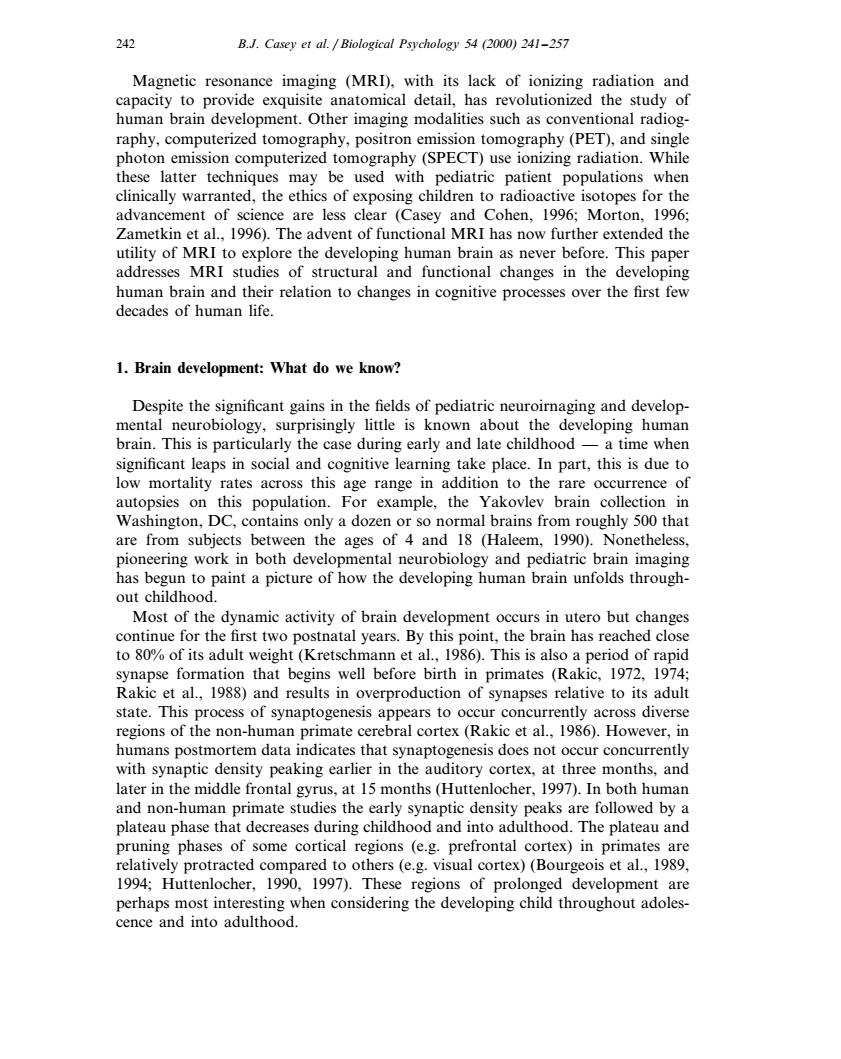正在加载图片...

242 B.J.Casey et al./Biological Psychology 54(2000)241-257 Magnetic resonance imaging (MRI).with its lack of ionizing radiation and capacity to provide exquisite anatomical detail,has revolutionized the study of human brain development.Other imaging modalities such as conventional radiog- raphy.computerized tomography,positron cmission tomography (PE)and singl oto the ompute raphy(SPECT While latter r tech 4 diatric c pa tient populations whe topes advancement of science are less clear (Casey and Cohen,1996;Morton,1996; Zametkin et al.,1996).The advent of functional MRI has now further extended the utility of MRI to explore the developing human brain as never before.This paper addresses MRI studies of structural and functional changes in the developing human brain and their relation to changes in cognitive processes over the first few decades of human life 1.Brain development:What do we know? Despite the significant gains in the fields of pediatric neuroirnaging and develop- mental neurobiology.surprisingly little is known about the developing human brain.This is particularly the case during early and late childhood-a time when significant leaps in social and cognitive learning take place.In part,this is due to s across this e range in additi to the on this populati example,the vlev brain co i DC,contains only a dozen o so normal brains from roughly 500 that are from subjects between the ages of 4 and 18 (Haleem,1990).Nonetheless, pioneering work in both developmental neurobiology and pediatric brain imaging has begun to paint a picture of how the developing human brain unfolds through- out childhood. Most of the dynamic activity of brain development occurs in utero but change continue for the fi P I years s.By the brain has reached close to 80 its adul L W g rets nn et a 6).This is als t begins well befor birth in primates (Rakic. al..1988)and results in overproduction of synapses relative state.This process of synaptogenesis appears to occur concurrently across diverse regions of the non-human primate cerebral cortex (Rakic et al..1986).However.in humans postmortem data indicates that synaptogenesis does not occur concurrently with synaptic density peaking earlier in the auditory cortex,at three months,and later in the middle frontal gyr us,at 15 months(Huttenlocher,1997).In both human and non- uma the synaptic density pe wed by plateau ph se tha decreases during ch and 1 to adulthood The plateau anc pruning phases of some cortical regions (e.g.prefrontal cortex)in primates are relatively protracted compared to others (e.g.visual cortex)(Bourgeois et al.,1989. 1994;Huttenlocher,1990,1997).These regions of prolonged development are perhaps most interesting when considering the developing child throughout adoles- cence and into adulthood. 242 B.J. Casey et al. / Biological Psychology 54 (2000) 241–257 Magnetic resonance imaging (MRI), with its lack of ionizing radiation and capacity to provide exquisite anatomical detail, has revolutionized the study of human brain development. Other imaging modalities such as conventional radiography, computerized tomography, positron emission tomography (PET), and single photon emission computerized tomography (SPECT) use ionizing radiation. While these latter techniques may be used with pediatric patient populations when clinically warranted, the ethics of exposing children to radioactive isotopes for the advancement of science are less clear (Casey and Cohen, 1996; Morton, 1996; Zametkin et al., 1996). The advent of functional MRI has now further extended the utility of MRI to explore the developing human brain as never before. This paper addresses MRI studies of structural and functional changes in the developing human brain and their relation to changes in cognitive processes over the first few decades of human life. 1. Brain development: What do we know? Despite the significant gains in the fields of pediatric neuroirnaging and developmental neurobiology, surprisingly little is known about the developing human brain. This is particularly the case during early and late childhood — a time when significant leaps in social and cognitive learning take place. In part, this is due to low mortality rates across this age range in addition to the rare occurrence of autopsies on this population. For example, the Yakovlev brain collection in Washington, DC, contains only a dozen or so normal brains from roughly 500 that are from subjects between the ages of 4 and 18 (Haleem, 1990). Nonetheless, pioneering work in both developmental neurobiology and pediatric brain imaging has begun to paint a picture of how the developing human brain unfolds throughout childhood. Most of the dynamic activity of brain development occurs in utero but changes continue for the first two postnatal years. By this point, the brain has reached close to 80% of its adult weight (Kretschmann et al., 1986). This is also a period of rapid synapse formation that begins well before birth in primates (Rakic, 1972, 1974; Rakic et al., 1988) and results in overproduction of synapses relative to its adult state. This process of synaptogenesis appears to occur concurrently across diverse regions of the non-human primate cerebral cortex (Rakic et al., 1986). However, in humans postmortem data indicates that synaptogenesis does not occur concurrently with synaptic density peaking earlier in the auditory cortex, at three months, and later in the middle frontal gyrus, at 15 months (Huttenlocher, 1997). In both human and non-human primate studies the early synaptic density peaks are followed by a plateau phase that decreases during childhood and into adulthood. The plateau and pruning phases of some cortical regions (e.g. prefrontal cortex) in primates are relatively protracted compared to others (e.g. visual cortex) (Bourgeois et al., 1989, 1994; Huttenlocher, 1990, 1997). These regions of prolonged development are perhaps most interesting when considering the developing child throughout adolescence and into adulthood